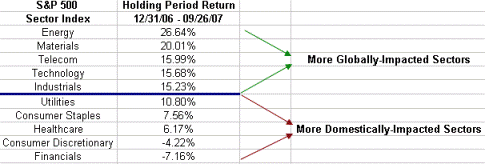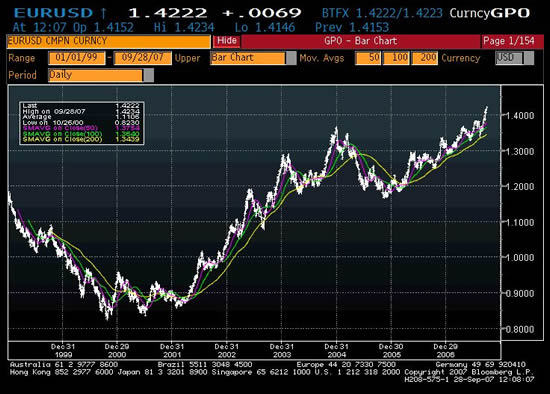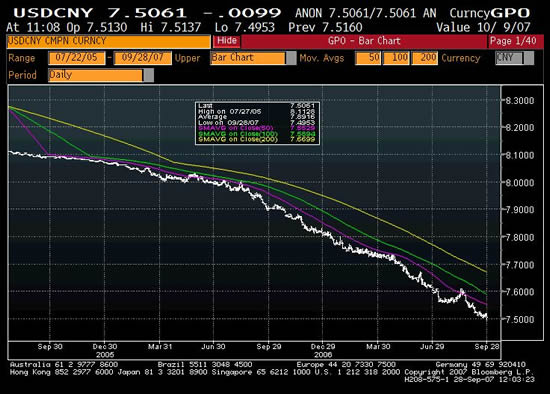| A Bull Market and a Recession? |
| By John Mauldin |
Published
09/29/2007
|
Currency , Futures , Options , Stocks
|
Unrated
|
|
|
|
A Bull Market and a Recession?
The dollar reaches new lows. The housing market shows no sign of a bottom. Oil almost touches $84 before backing off. Interest rates go up after the Fed cuts. So naturally the stock market keeps climbing. But then, consumer spending came in strong, employment looks like it may be ok, inflation (at least by one measure) came in below 2%. This week we look at the question of whether you could have a continued bull market and a recession. (Maybe.) We look at the bigger picture for the dollar and interest rates and examine the ugly data from the housing sector. Inflation or deflation?
Inflation Is Not a Problem - Until It Is
The Fed cut its fund rate by 50 basis points and the stock market has rejoiced. But the bond vigilantes came out in full force. The last three times the Fed initiated a new easing cycle, ten year bond yields typically dropped 20 basis points or more in the next five days. This time they rose by 20 basis points. Since mortgages rates are typically geared of the yield of the ten year bond, this is a cut that has not helped the consumer as of yet.
Clearly, the bond market is worried about inflation, or worse - stagflation. It's that 70 show all over again. The market should start worrying about something else. Inflation is not a problem in a recession, and certainly one caused by the bursting of the largest housing bubble in US history. Be definition, those are deflationary events.
If we have a simple slowdown I think rates drop to 4% or less. If we see a recession, short term rates will drop below 3%. Van Hoisington, manager of the best performing long term bond fund over the past five years (and frequent Outside the Box contributor), said today that he thinks that yields on 30 year bonds will drop below 4%, from the 4.84% they are positioned at today.
Hoisington thinks that GDP is "going to be very slow in the fourth or first quarter, close to zero in one of the two." The head of Freddie Mac now estimates that there is a 40-45% chance of a recession. And the core PCE (Personal Consumption Expenditures), the Fed's preferred measure of inflation, dropped below 2% for the first time in a long time, down to 1.8%. The Dallas Fed uses sits own version of the PCE, called the trimmed PCE (which includes food and energy), which shows inflation is now edging down below 2%.
That will give the Fed room to cut rates in the last two meetings of the year. And the data that came out on housing suggests they will need to.
The House of Pain
Let's slice and dice the latest housing data and see just how bad it is if you are trying to sell a home. (Most of the data is from data-maven Greg Weldon at www.weldononline.com.)
First the inventory of existing homes rose yet again to 4,581,000, which is an increase of more than 1,000,000 since March alone. It is more than double the supply since the beginning of 2005. In January there was a 6.6 months supply of homes for sale. Now it is 10 months. Over 500,000 homes are in the process of foreclosure and will soon come onto the market. I think that means in the near future we will see a 12 month supply of existing homes for sale.
Remember, that is an average. In some markets, that means there may be a two year supply and a three month supply in areas of higher demand. It is going to become a buyer's market in the middle of next year as sellers
Want to buy a condo? Existing condos for sale have risen by 35% since January to 661,000. That is almost 12 months of supply, and there are a lot of new condos coming onto the market as there are a lot of construction projects that are just now nearing completion.
New home sales in August saw the largest decline in three decades, down 8.3%. Mean new home prices are down 11% in the last five months. The inventory of new homes for sale is up to 8.2 months and rising.
Greg also spotted something which I suspected and hinted about in previous letters. The number of homes above $750,000 which are selling is down by over 35% from last year. Sales of home from $500,000 to $749,000 is down by 25%. Jumbo mortgages are just hard to find at rates that make sense. I think it is likely that Congress will allow Fannie and Freddie to take larger loans onto their books. I would not be shocked to see the number at $600,000, at least temporarily. Right now they are limited to taking $417,000 loans. With a 20% down payment that means about $525,000 for the sales price of the home.
All this means that the fall-out from the housing recession is still in our future. I expect to be able to take out the e-letters I wrote on the problems of deflation back in 2002 and update them sometime next year. Again, recessions and the bursting of bubbles are profoundly deflationary.
The Return of Muddle Through
It is going to take some time for the economy to work itself through the current credit crisis and the collapse of the housing bubble. I suspect the US economy will grow below trend for at least another year. We will work through it, as we always do. But it is the return of the Muddle Through Economy.
How long it takes to work back to a 3% GDP depends on how fast the credit markets can figure out how to create a structured security and a collateralized debt obligation market. Without those structures, all sorts of consumer loans and mortgages will be more expensive and difficult to get.
In the Financial Times today, Jan Krahnen suggested that a new type of mortgage back security be created that kept the first risk of loss with the initial lending institution. In the past, a securitized loan was divided into five different segments called tranches. The lowest rated tranche was called the equity tranche because it took the first losses in the pool of loans.
What Krahnen suggested that instead of letting a mortgage bank sell of 100% of the loan, they have to keep the equity tranche. That way, they suffer the loss if the borrowers don't pay. They are first in line for the moral hazard of losses. That would tend to focus the management of the bank in the direction of making good loans rather than merely taking fees. Investors could have more confidence in the loan making process.
That makes immanent sense to me. Of course, it would mean that larger institutions or more capitalization would be needed on the part of mortgage lenders, but it would get the market going again.
A Bull Market and a Recession?
Changing pace, as most readers know, it has been my contention for almost a year that the bursting of the housing bubble would result in a mild recession or at the least a serious slowdown. And a recession has always meant a full blown bear market in the stock market (an average drop of over 40%). But even if there is a recession, there may be reason to argue that the large cap market indexes will not see as severe a drop as has been the case in the past. Why not?
I ran across an interesting thought by Michael Albert on his blog at www.leadlag.com. We corresponded and he made the following charts for me. Notice that certain sectors of the S&P 500 are on a tear since the first of the year, like energy, material and technology.

The sectors that are outperforming are all large multi-nationals that get as much as 50% of their earnings from outside the US, and the global economy is doing well. Those that are not doing well are tied to US domestic consumer spending and the financials.
Now let's look at the weightings of the various sectors in the S&P 500. Notice that almost 60% of the cap weighting is to industries that get a good portion of their earnings from overseas, or are largely insulated from a slowdown in overall consumer demand (like healthcare which you buy when you need it, not generally as a discretionary item). Utilities should do well in a falling interest rate environment.

If we saw a 30% drop in the 40% domestically impacted sectors (with healthcare and utilities basically flat) and a 10% rise in the rest, that would be an overall drop of only about 7%, which is not much of a bear market in the total index, although there would be sectors that are ugly.
That also argues that large cap multinational stocks will outperform smaller firms. The Dow will beat the Russell 2000, as an example. This may be one reason that legendary fund manager Bill Miller of Legg-Mason, who beat the Standard & Poor's 500 Index for 15 straight years until 2006, is rotating out of mid-caps and into very large caps, to insulate himself from a potential slowdown or recession.
King Dollar and the Guillotine
In February of 2002 I turned bullish on gold in this letter (after having been a bear for at least 15 years) and in early March of that year I wrote a letter called "King Dollar and the Guillotine" where I outlined the reasons that the dollar was getting ready for a rather long slide. The euro was at $.88 and I suggested that we could see dollar parity by the end of the year, which we did.
In May of the next year, with the euro around $1.07, I suggested that $1.40 was possible. In later letters I suggested that $1.50 is possible, although I admit that when France and the Netherlands rejected the constitution I lowered my "target" back to $1.40, with the euro around $1.20 at the time.
The dollar closed at $1.42 this afternoon. Now $1.50 doesn't seem all that far, just another 5% move. Let's look at a chart of the euro since it was introduced and then I will make some comments.

The euro was introduced January 1, 1999 and had a value of $1.19. It promptly started falling and reached a low of around $.82 shortly before the end of 1999. There were a number of reasons for the drop, but the euro clearly became seriously undervalued.
It has risen over 70% since that low and over 60% since I wrote about it in 2002. That is a very large movement. But if you view it from the introduction in 1999, that is only about a 20% move in almost nine years. It is also only up 10% since the end of 2003, again not all that large a move for almost 4 years. But that is because the euro rose too fast and then went sideways for two years, before once again renewing a very defined upward trend for the last two years.
A little rest for the euro would be in order. It would not surprise me to see the euro drop a little from here before resuming its upward journey. I read that 90% of currency traders are dollar bearish versus the euro. When everyone is on the same side of a trade that is usually when the trend is getting ready to reverse, at least for awhile.
Before we leave the euro, I should note that I expect the euro to go back to parity over a long period of time, maybe a decade or more. But that's a story for another letter.
The Canadian dollar went to parity this week, which I first suggested was possible four years ago. That used to get laughs in Canada, as the audience waited for the punch line. It could easily get stronger.
But where we should be paying attention is Asia and in particular the Chinese yuan. It also made new highs against the dollar. It has risen almost 10% in a little over two years, bouncing off its 50 day moving average with regularity. And I think it is being set up to rise at a faster pace. A $6 yuan is certainly in the realm of possibility, and not too far into the next decade.

The Chinese have a problem. Everyone "knows" that the Chinese yuan is going to rise, probably by another 20% at least. So, what do you do? You invest in China, typically in real estate or manufacturing centers, and watch your investment rise 20% just from currency appreciation. That has created a bubble in certain types of businesses and real estate markets, and threatens to destabilize their economy if it were to continue. The Chinese government is actively trying to discourage property speculation, but an under-valued yuan makes that difficult.
Further, if you allowed the yuan to float, but kept a lock on Chinese business and investors from investing outside of the country, it would put even more serious pressure on the yuan to rise, and it could do so rapidly and destabilize the economy. The Chinese government does not want anything to destabilize the economy.
A controlled currency is also creating inflationary pressures. Plus, the US and other western nations are not happy with the low value of the yuan. Not that the Chinese care all that much about what we think, but a trade war does no one any good.
You may not have read about it yet, but there is a tsunami of money getting ready to come from China into the world. And I am not talking about the large government balances or their new sovereign wealth fund.
This week, the Chinese announced they are going to let one of their larger mutual funds invest outside of China. Local Chinese investors will be able to start to diversify and businesses will start to be able to take their capital and employ it abroad. This is just the start of the process. I expect that in just a few years Chinese will be able to buy a wide range of funds and investments.
This will take off a lot of the market pressure for a stronger yuan, as the Chinese will need to buy dollars and euros and other currencies in order to make those investments. Further, those who have invested in China at some point are going to want to take their profits back home.
I think we will see the Chinese government open up the potential to invest and spend abroad before they float their currency. This will allow them to let them get closer to allowing the yuan to float. It is in their best interest to do so over the next few years.
John Mauldin is president of Millennium Wave Advisors, LLC, a registered investment advisor. Contact John at John@FrontlineThoughts.com.
Disclaimer
John Mauldin is president of Millennium Wave Advisors, LLC, a registered investment advisor. All material presented herein is believed to be reliable but we cannot attest to its accuracy. Investment recommendations may change and readers are urged to check with their investment counselors before making any investment decisions.
|
|